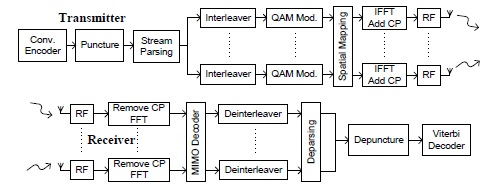- ALL COMPUTER, ELECTRONICS AND MECHANICAL COURSES AVAILABLE…. PROJECT GUIDANCE SINCE 2004. FOR FURTHER DETAILS CALL 9443117328


Projects > ELECTRONICS > 2017 > IEEE > COMMUNICATION
We present a low-complexity link adaptation algorithm for maximizing the energy efficiency (EE) of MIMOOFDM systems. We prove that the energy efficiency is a single peaked quasi concave function of the transmit power and develop an iterative algorithm to find near-optimal transmit power. We further prune the search space by analyzing the singular values of the channel. The resulting link adaptation protocol achieves orders of magnitude reduction in complexity compared to the brute force search method without noticeably sacrificing the performance.
Energy-Constrained Modulation Optimization, Bit-Interleaved Coded Modulation.
In this paper, we formulated the energy efficiency of a MIMO-OFDM system using realistic PER and energy consumption models. We proved the existence and uniqueness of the optimal transmit power when we fix other transmission parameters and developed an iterative algorithm, which finds a near-optimal transmit power on the average. The main contributions of this work can be summarized as follows: We formulate the energy efficiency maximization of MIMO-OFDM systems using a fully mathematical packet error rate (PER) performance model based on post processing SNR (PPSNR) and an inclusive energy consumption model. It turns out that the brute force search over all optimization variables, which is usually assumed in previous works, is prohibitively complex, especially when there are large numbers of transmit power levels to choose from. We analyze the energy efficiency and transmit power relationship and prove that EE is a single-peaked quasi concave function of the transmit power. This proof leads us to develop a low-complexity iterative algorithm that finds a near-optimal transmit power and takes this dimension out of the search space. We analyze the relationship between the PPSNR and the singular values of the channel, and use this relationship to prune the search space by excluding the modes that use higher number of spatial streams than the channel can support. We show that we can compute the PPSNRs using the singular value decomposition (SVD) of the channel and at the same time eliminate about 38% of the computations simply by looking at the singular value ratios of the channel. These algorithms limit the search space into a much smaller set and hence reduce the computational complexity of the protocol by orders of magnitude without sacrificing the performance. We present realistic link level simulations to prove the energy efficiency gains.
BLOCK DIAGRAM
